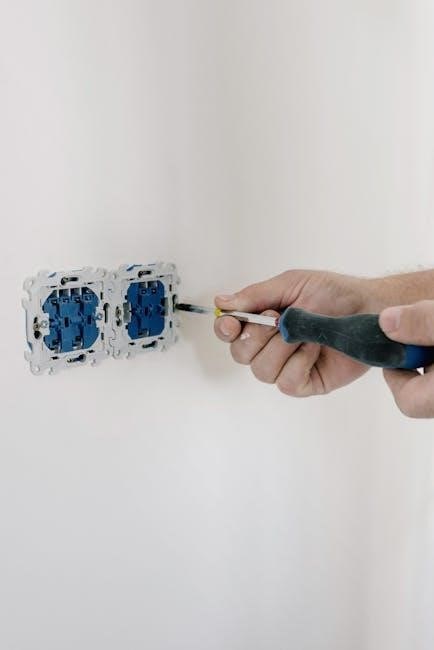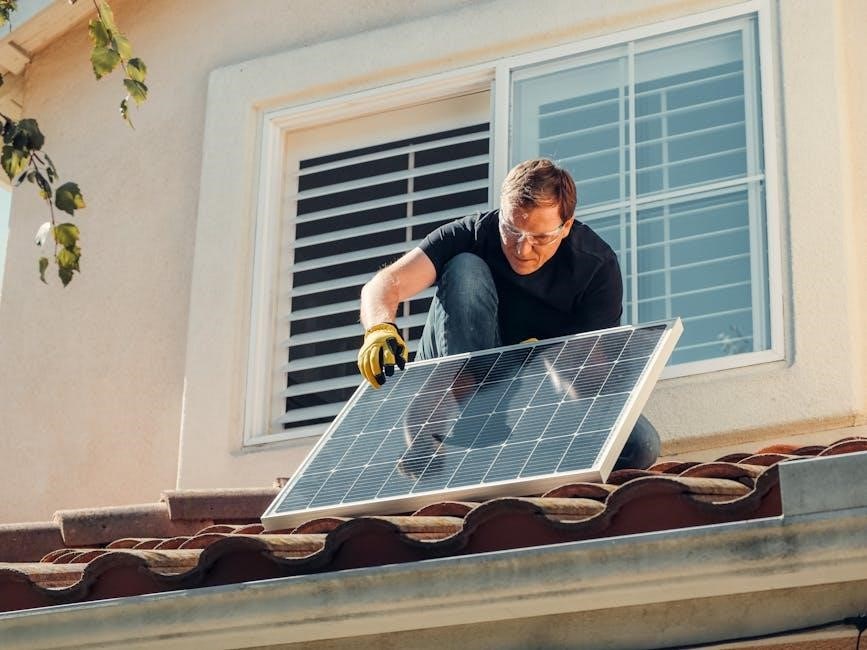
Honeywell TH5220D1029 Installation Guide
Welcome! This guide provides comprehensive instructions for the installation of your Honeywell TH5220D1029 FocusPRO 5000 thermostat. Follow these steps carefully to ensure proper wiring, mounting, and installer setup for optimal performance.
The Honeywell TH5220D1029 FocusPRO 5000 is a non-programmable digital thermostat designed for ease of use and reliable performance. It offers electronic control for various heating and cooling systems, including gas, oil, and electric. This thermostat is suitable for both residential and commercial applications, providing accurate temperature management without complex programming requirements.
Its simple interface and clear display make it easy to adjust temperature settings. The TH5220D1029 can be powered by batteries or system power. Proper installation is crucial for optimal operation. This guide will walk you through each step, from wiring to mounting, ensuring a successful setup.
Package Contents and Necessary Tools
Before beginning the installation, verify that all components are present. The package should contain the Honeywell TH5220D1029 thermostat unit, the wallplate for mounting, and an installation guide. Ensure you also have the necessary screws and anchors for securing the wallplate to the wall.
To complete the installation, you will need a few essential tools. A Phillips head screwdriver is required for wiring and securing the thermostat. A small flathead screwdriver may also be useful. Wire strippers are necessary to prepare the wires for connection. Additionally, have a level to ensure the wallplate is mounted straight. A flashlight can aid in viewing the wiring connections.

Pre-Installation Steps
Before you begin, safety first! Disconnect power to your heating/cooling system; Then, carefully remove your old thermostat to prepare for the Honeywell TH5220D1029 installation.
Disconnecting Power Supply
Prior to commencing any installation work on your Honeywell TH5220D1029 thermostat, it is absolutely crucial to disconnect the power supply to both your heating and cooling systems. This safety measure is paramount to prevent electrical shock or potential damage to the equipment during the wiring process. Locate the appropriate circuit breaker or switch that controls the power to your HVAC system and turn it off.
To ensure complete safety, it’s recommended to double-check that the power is indeed disconnected by testing the wires with a non-contact voltage tester. This simple precaution can prevent serious injury and ensure a safe installation process. Never assume the power is off; always verify it. This step is non-negotiable.
Removing the Old Thermostat
With the power safely disconnected, you can proceed to remove your old thermostat. Begin by carefully detaching the thermostat body from its wallplate. Most thermostats are either snapped on or held in place by screws. Once the body is removed, you’ll have access to the wiring connections.
Before disconnecting any wires, it’s essential to label each wire with its corresponding terminal on the old thermostat. This will greatly simplify the wiring process for your new Honeywell TH5220D1029. You can use small pieces of masking tape or wire labels for this purpose. After labeling, carefully disconnect each wire. Finally, unscrew the old wallplate from the wall, preparing the surface for the new installation. Keep all screws safe.
Mercury Warning (If Applicable)
Important Safety Notice: If your old thermostat contains mercury in a sealed glass tube, it is crucial to handle it with extreme caution. Mercury is a hazardous substance, and improper disposal can pose environmental and health risks. Do not break or puncture the tube.
Carefully remove the thermostat from the wall without damaging the mercury capsule. Refer to local regulations for proper disposal methods. Many municipalities have specific collection programs for mercury-containing devices. If you are unsure how to dispose of the old thermostat, contact your local waste management authorities or environmental agency for guidance. Never dispose of a mercury thermostat in regular household trash. By following these instructions, you can ensure safe and responsible disposal.

Wiring and Mounting
This section details the procedures for wallplate installation, making secure wiring connections, and properly mounting the Honeywell TH5220D1029 thermostat to the wall. Electrical safety is paramount during these steps.
Wallplate Installation
Begin by removing the wallplate from the Honeywell TH5220D1029 thermostat. Next, carefully pull the existing wires through the designated wire hole in the wallplate. Position the wallplate against the wall at the desired location, ensuring it is level for accurate thermostat operation. Use appropriate screws and anchors to securely mount the wallplate to the wall.
Ensure that the wallplate is flush against the wall to prevent any gaps that could affect temperature readings. The mounting process is crucial for stability and proper alignment. Correct installation of the wallplate contributes to the overall performance and longevity of your new thermostat.
Wiring Connections
Before beginning, ensure the power supply is disconnected to prevent electrical hazards. Carefully connect the wires from your HVAC system to the corresponding terminals on the Honeywell TH5220D1029 thermostat’s wallplate. Refer to the wiring diagram included with the thermostat for accurate connections. Each wire should be securely fastened to its designated terminal to avoid loose connections.
Double-check all wiring connections to ensure they match the diagram and are properly tightened. Incorrect wiring can lead to equipment damage or malfunction. If you are unsure about any connection, consult a qualified technician. Proper wiring ensures the thermostat communicates effectively with your heating and cooling system.
Mounting the Thermostat
Once the wallplate is securely installed and all wiring connections are completed, carefully proceed with mounting the Honeywell TH5220D1029 thermostat. Gently align the thermostat with the wallplate, ensuring that the pins on the back of the thermostat line up correctly with the corresponding slots on the wallplate.
Push the thermostat firmly but carefully onto the wallplate until it snaps into place. Avoid excessive force, as this could damage the thermostat or the wallplate. Once mounted, ensure the thermostat is securely attached to the wallplate and does not wobble. The thermostat should sit flush against the wall for proper operation and accurate temperature readings.

Installer Setup and Configuration
After mounting, proceed to installer setup. This configures the thermostat to match your system. Access the installer setup to specify system type and other settings for proper operation.
Accessing Installer Setup
To begin configuring your Honeywell TH5220D1029, you’ll need to access the installer setup menu. This allows customization of various parameters to match your specific heating and cooling system requirements. Consult your manual.
The method to enter installer setup typically involves pressing a combination of buttons on the thermostat. Refer to the installation manual for the exact sequence, as it may vary slightly depending on the model. Once in the setup menu, you can navigate through the options using the up and down buttons, making adjustments as needed. Be certain of your actions.
Configuring System Type (Heating/Cooling)
Once you’ve accessed the installer setup, the next crucial step is configuring the system type. This involves specifying the type of heating and cooling system connected to your Honeywell TH5220D1029. Common options include: heat pump, conventional systems (gas, oil, electric), and heat-only or cool-only setups. Selecting the correct system type is essential for proper operation.
Use the navigation buttons to locate the system type setting within the installer setup menu. Choose the option that accurately reflects your home’s heating and cooling configuration. Incorrect settings can lead to inefficient performance. The manual will guide you.

Post-Installation Checks
After installation, thoroughly verify that your Honeywell TH5220D1029 is operating correctly. This includes confirming heating and cooling activation, fan operation, and addressing any troubleshooting needs that may arise post installation.
Verifying Proper Operation
Following the installation of your Honeywell TH5220D1029 thermostat, confirming its proper operation is crucial. Begin by setting the thermostat to ‘Heat’ mode and ensure the heating system activates. Verify the temperature rises as expected. Next, switch to ‘Cool’ mode and confirm the air conditioning engages, lowering the room temperature. Test the fan settings – ‘Auto’ and ‘On’ – to ensure the fan responds accordingly.
Pay close attention to any unusual noises or delays during system activation. If you encounter any discrepancies, consult the troubleshooting section of this guide. Confirm that the display is clear and responsive, and that the set temperature matches your comfort preferences. This thorough verification ensures efficient and reliable performance from your new thermostat, improving comfort and potentially saving energy.
Troubleshooting Common Issues
If your Honeywell TH5220D1029 thermostat isn’t functioning as expected, several common issues can be easily addressed. First, if the display is blank, check the power supply or batteries. Ensure correct polarity if batteries are used. If the heating or cooling system doesn’t activate, verify the wiring connections are secure and match the system requirements.
Double-check the system type configuration in the installer setup menu to ensure it aligns with your heating/cooling setup. An incorrect setting can prevent proper operation. If the temperature readings seem inaccurate, recalibrate the thermostat following the manual’s instructions. For unresponsive buttons, try resetting the thermostat to its factory defaults. If issues persist, consult a qualified HVAC technician. Remember to always disconnect power before inspecting wiring.
Recycling and Disposal
Properly dispose of your old thermostat and packaging materials. Follow local instructions for recycling electronic components. Consult your local waste management services for specific guidelines regarding thermostat disposal.
Proper Disposal of Old Thermostat
When replacing your old thermostat with the Honeywell TH5220D1029, it is crucial to handle the disposal of the old unit responsibly. Many older thermostats contain mercury, a hazardous material that can be harmful to the environment and human health if not disposed of correctly. Disconnect power to the old thermostat before removing it.
Check the device for any markings indicating the presence of mercury. Do not dispose of thermostats containing mercury in regular household trash. Instead, contact your local waste management or environmental agencies for information on proper collection and disposal programs for items containing mercury.
Participating in these programs ensures that the thermostat is handled safely, minimizing potential environmental damage and promoting responsible waste management practices. Some manufacturers also offer take-back programs for old thermostats, providing a convenient and environmentally sound disposal option.
Recycling Instructions
After properly disposing of your old thermostat, consider the recycling instructions for the packaging and components of your new Honeywell TH5220D1029. The packaging materials, such as cardboard and paper, can typically be recycled through your local recycling program. Check the packaging for recycling symbols and guidelines.
For the thermostat itself, Honeywell promotes environmental responsibility. Contact your local recycling center to inquire about electronics recycling programs. These programs often accept thermostats and other electronic devices, ensuring that valuable materials are recovered and properly processed.
By actively participating in recycling efforts, you contribute to reducing waste, conserving resources, and minimizing the environmental impact associated with electronic products. Remember to remove any batteries from the thermostat before recycling, and dispose of them separately according to local regulations for battery disposal.